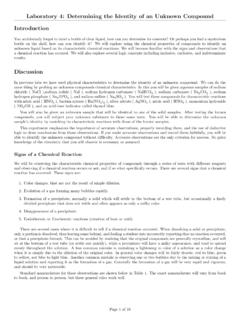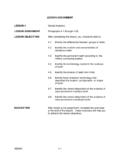Transcription of Laboratory 21: Properties of Alkanes, Alkenes, and Alkynes ...
1 Laboratory 21: Properties of alkanes , alkenes , and AlkynesIntroductionHydrocarbons are organic compounds composed entirely of carbon and hydrogen atoms. They are obtained primarily fromnatural sources such as coal, petroleum, and natural gas. Hydrocarbons differ primarily in the functional group. Thisexperiment will examine how the different functional groups in alkanes , alkenes , Alkynes , and Aromatic hydrocarbons leadto different physical and chemical Classes of HydrocarbonsHydrocarbons can be divided into several different classes depending on the functional group present. The following fourclasses of compounds will be composed of hydrocarbons having only single bonds between carbon (C C) atoms. They are often referred to assaturatedhydrocarbons because the molecule contains the maximum number of hydrogen atoms attached to each have a generic formula given by CnH2n+2.
2 alkanes generally react via asubstitutionmechanism where two moleculesexchange atoms, as illustrated below where X is any CH2 H + X X R CH2 X + HXswapAlkenesAre composed of hydrocarbons containing at least one carbon-carbon double bond (C C). They are unsaturated in thatthe have two less hydrogens then the corresponding Alkane. They have a generic formula given by CnH2n. The carbon-carbondouble bond is a point of high reactivity, and most chemical reactions of alkenes occur by theadditionmechanism wherethe carbon-carbon double bond is broken and the reacting molecules are added to the Alkene. An example is shown below:CHHCHHB onds Broken+ H-ClCHHCHH+HClRadicals FormedCHHHCHHClNew Bonds FormedAlkynesAre composed of hydrocarbons containing at least one carbon-carbon triple (C C)bond. They are considered unsaturatedand have a generic formula given by CnH2n 2.
3 The carbon-carbon triple bond is a point of high reactivity and Alkynes tendto react in similar manner to composed of hydrocarbons based on the benzene ring (C6H6) Benzene is composed of a 6-member ring containingalternating carbon-carbon double bonds. From its formula benzene appears to be a highly unsaturated molecule, however,the benzene ring itself is unusually stable and it chemically reacts more like a saturated hydrocarbon in many respects andgenerally 1 of 12 Laboratory 21: Properties of alkanes , alkenes , and AlkynesB. Physical PropertiesWhen a compound burns in the presence of oxygen the reaction is called a combustion. Like most organic substances,hydrocarbons are combustible. The general reaction is given Compound + O2(g) CO2(g) + H2O(g) + Heat/Energy(1)Complete combustion occurs when there is enough oxygen to fully convert all the carbon atoms in the organic compoundto carbon dioxide and the hydrogen atoms to water.
4 Incomplete combustion occurs when there is insufficient oxygen to reactwith carbon, resulting in some carbon atoms not reacting and forming a black addition we will explore the solubility of hydrocarbons in water and with respect to each other. A review of solubilitycan be found in Hein Chapter Chemical PropertiesWe will be examining how various hydrocarbons react with several standard with BromineEach hydrocarbon will be reacted with a bromine solution. Bromine reacts with carbon-carbon double and triple bondsbyadditionacross the double bond. Disappearance of the characteristic bromine color (reddish/orange) within 10 secondsindicates indicates that it has reacted with a double or triple bond of a CH CH CH3 Colorless+Br2 Red/Orange FastCH3 CHBr CHBr CH3 Colorless(2)Bromine will react with carbon-carbon single bonds in alkanes by replacing a H with Br bysubstitution, however, thereaction is generally slow and requires light to act as a +Br2 Red/OrangeLight SlowCH3CH2 BrColorless+HBrPungentOdor(3)Bromine does not react with benzene (aromatic rings) due to the stable resonance structure, but can react with functionalgroups attached to + Br2 No Reaction(4)Potassium PermanganateEach hydrocarbon will also be reacted with potassium permanganate, a strongoxidizingagent.
5 This test is commonlyknown as theBaeyertest for unsaturation. The carbon-carbon double and triple bonds are oxidized to form alcohols ordiols (Hein Chapter 22). Evidence that the reaction has occurred is the rapid disappearance (within a few seconds) of thepurple permanganate color. The resulting reaction products will generally be colored, typically a brown solid, but varies withreaction + KMnO4 Purple Diol + MnO2(s)Coloredppt(5)Page 2 of 12 Laboratory 21: Properties of alkanes , alkenes , and AlkynesProcedureA. Combustion1. Perform the following test in the hood (be sure the hood is turned on).2. Remember hot things are Place about 1 mL of the substance to be tested in an evaporating Ignite the liquid using a wood splint or lighter. Dispose of the splint in the labelled container in the Record your observations noting the characteristics (color, amount of smoke) of each flame along with any evidence ofresidue left behind in the evaporating Repeat for each of the substance to be Solubility Tests1.
6 Test the solubility of each of the listed substance with water by adding 1 mL (or less) of the first liquid hydrocarbonto 5 mL of distilled water (or second hydrocarbon) in a test Mix each of the test tubes vigorously for 15 seconds. Wait 30 seconds. Sketch a picture of your results. In the sketch,label each liquid in the test tube. Note which pairs are miscible and which are For any solutions that are insoluble note the relative density of the hydrocarbons with respect to Dispose of the solutions in the waste bottle labelled E21 Waste .C. Reaction with Bromine1. Do the following test under the hood. Be especially careful with the bromine solution and if spilled notify your instructorimmediately and wash your In a clean test tube place 1 mL of the solution to be To the solution add 3 drops of the 1% bromine solution in Swirl the tubes gently to mix Note any results after 2 minutes.
7 Record any color Any test tube that still shows the bromine color after 2 minutes, should be exposed to the ultraviolet light for anadditional 5-10 minutes. Note any changes. Record any color Dispose of the contents of the test tubes in the waste bottle labelled E21 Waste .D. Reaction with Potassium Permanganate1. In a clean test tube place 1 mL of the solution to be To the solution add 5 drops of the potassium permanganate Swirl the tubes gently to mix Note any results after 1 minute. Record any color Dispose of the contents of the test tubes in the waste bottle labelled E21 Waste .Page 3 of 12 Laboratory 21: Properties of alkanes , alkenes , and AlkynesE. Identity of an Unknown Hydrocarbon1. You must complete the tests with bromine and potassium permanganate (parts C and D) above before doing Determine which class of hydrocarbons (alkane, alkene, or alkyne) that your unknown belongs to by reacting it withboth bromine and potassium permanganate as described in the last two Acetylene1.
8 Fill a 1000 mL beaker 75% full with tap Fill 4 large test tubes (25 200 mm) with water as follows: Tube (1) completely full, Tube (2) 75% full, Tube (3)50% full, and Tube (4) 25% Obtain 4 corks to seal each test tube Obtain a small lump of calcium carbide from the reagent bottle. Drop it in the beaker of water as shown in the Placing your thumb over the test tube of water, invert the test tube into the Hold the test tube over the bubbling acetylene gas to collect the When the test tube is full of gas, remove it from the water and quickly stopper Repeat the above procedure until all 4 test tubes are Test the contents of the tube for Wrap each test tube in paper Bring the mouth of the test tube to a Bunsen burner, as you remove the After the acetylene ignites, tilt the mouth of the tube up and down several Record your Dispose of the solution in the beaker in the 4 of 12 Laboratory 21: Properties of alkanes , alkenes , and AlkynesName:Class:Date:ResultsA.
9 CombustionCompoundObservationsComplete Chemical ReactionHeptane1-HexeneTolueneTable 1: Results - Combustion1. Which compounds showed complete combustion, incomplete combustion? Combustion:Incomplete Combustion:2. What is the chemical identity of the residue left behind after some combustions. What evidence do you have to supportyour conclusion? 5 of 12 Laboratory 21: Properties of alkanes , alkenes , and AlkynesB. Solubility TestsMixtureObservation/SketchMiscible/I mmiscibleHeptane + Water1-Hexene + WaterToluene + WaterHeptane + 1-HexeneHeptane + Toluene1-Hexene + TolueneTable 2: Results - SolubilityPage 6 of 12 Laboratory 21: Properties of alkanes , alkenes , and Alkynes1. Which Hydrocarbons tested are soluble in water?2. From your observations what do you conclude about the density of the hydrocarbons with respect to water (less, more,the same).
10 From your observations of the different hydrocarbons, what can you conclude about their solubility with respect to eachother? What rule was learned in Hein Chapter 14 with regards to what type of substances are soluble with each other. Doesthe experiment above verify the rule? What property (thinking in terms of intermolecular forces) is different between water and the hydrocarbons that wouldexplain your results? 7 of 12 Laboratory 21: Properties of alkanes , alkenes , and AlkynesC/D/E. Reaction with Bromine and Potassium Permanganate and UnknownIf No Reaction occurs write NR in the ID:PartCReactionwithBr2(<2 min)PartCReactionwithBr2(5-10 min +UV light)PartDReactionwithKMnO4 Table 3: Results - Reaction with Bromine and Potassium Permanganate and Unknown1. Which compounds reacted slow? Which reacted fast? Did the results match the expected results?








